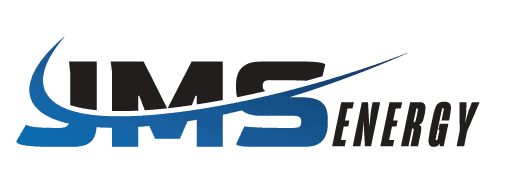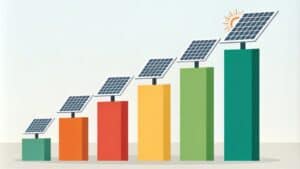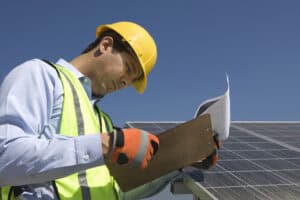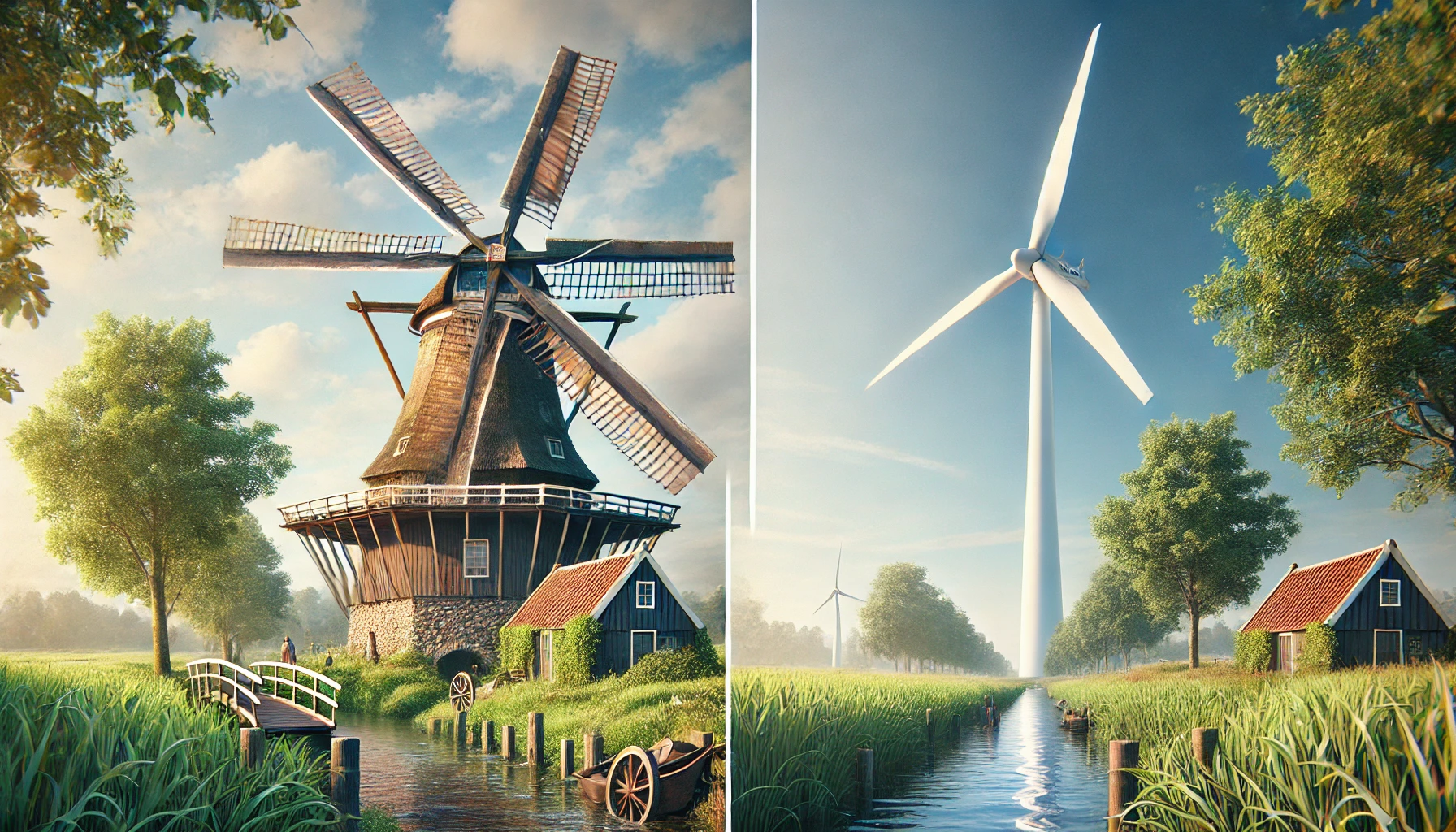
Table of Contents
Windmills or Wind Turbines? When driving through America’s vast countryside, you might spot tall, sleek structures with massive rotating blades reaching toward the sky. While many people casually refer to these as “windmills,” they’re actually wind turbines – and the difference is more than just semantic. Let’s explore these two technologies with the help of insights from JMS Energy, a leading force in renewable energy with over three decades of experience in the wind power industry.
The Historic Windmill: More Than Just Don Quixote’s Nemesis
Windmills have been around for over a millennium, with the earliest recorded designs dating back to ancient Persia around 500-900 CE. These traditional structures were revolutionary for their time, harnessing wind energy to perform mechanical work directly. The classic Dutch windmill, for instance, would use wind power to pump water or grind grain into flour – hence the “mill” in windmill.
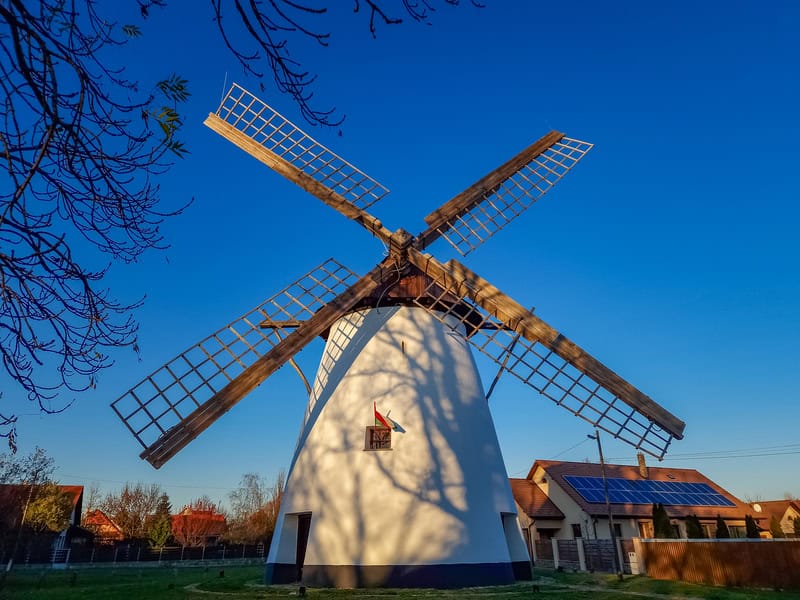
The Evolution of Windmill Technology
The journey of windmill technology tells a fascinating story of human innovation:
- Persian Windmills (500-900 CE)
- Vertical axis design
- Used for grinding grain
- Built from reed mats and wood
- Featured 6-12 sails
- European Post Mills (1200s)
- First horizontal axis designs
- Entire structure rotated to face the wind
- Primarily used for grinding grain
- Four-blade wooden design
- Dutch Windmills (1400s-1800s)
- Tower mills with rotating caps
- Multiple levels for different operations
- Used for draining polders (low-lying land)
- Complex gearing systems
- American Farm Windmills (1800s)
- Steel construction
- Self-regulating design
- Primarily used for water pumping
- Multiple small blades in a wheel configuration
Traditional windmills convert wind energy into mechanical energy through a direct drive system. The spinning blades connect to millstones or pump mechanisms, creating a simple but effective machine that helped power agricultural communities for centuries.
Modern Wind Turbines: Power Plants in the Sky
In contrast, wind turbines, like the thousands installed by JMS Energy across 32 states, are sophisticated power generation facilities. These modern marvels convert wind energy into electrical power through a complex system of components. When wind pushes against the aerodynamically designed blades, they rotate a shaft connected to a generator, which produces electricity that feeds into the power grid.
Anatomy of a Modern Wind Turbine
Let’s break down the key components that make these giants work:
- Blades
- Aerodynamic design based on aircraft wing principles
- Usually made from composite materials like fiberglass and carbon fiber
- Length can exceed 265 feet
- Pitch control systems adjust angle for optimal performance
- Nacelle
- Houses the generator and gearbox
- Contains sophisticated monitoring equipment
- Features cooling systems
- Includes yaw control to face the wind
- Tower
- Heights reaching over 500 feet
- Built to withstand extreme weather
- Contains power cables and access ladder
- Features multiple internal platforms
- Foundation
- Extensive underground concrete structure
- Engineered for specific soil conditions
- Can use up to 500 cubic yards of concrete
- Designed to last 25+ years
Since 2008, JMS Energy has installed over 6,500 wind turbines, contributing significantly to America’s renewable energy infrastructure. Each turbine is a testament to modern engineering, featuring advanced technologies like:
- SCADA systems for remote monitoring and control
- Sophisticated blade designs that maximize energy capture
- Complex electrical systems for power conversion and transmission
- Smart grid integration capabilities
- Advanced weather monitoring systems
- Predictive maintenance technology
The Science Behind the Spin
Windmill Physics
Traditional windmills operate on relatively simple principles:
- Direct mechanical energy transfer
- Fixed or manually adjusted blade angles
- Limited speed control
- Primarily operates in lower wind speeds
- Efficiency focused on mechanical power transfer
Wind Turbine Aerodynamics
Modern wind turbines employ sophisticated aerodynamic principles:
- Bernoulli’s principle for lift generation
- Variable pitch control for optimal performance
- Cut-in and cut-out wind speeds for safety
- Complex wake management in wind farms
- Advanced materials for reduced turbulence
JMS Energy: Powering the Wind Revolution
With their extensive experience in wind energy, JMS Energy has witnessed and participated in the evolution of wind power technology. Their portfolio includes everything from initial site assessment and design to construction and maintenance of wind facilities. Their comprehensive capabilities include:
Design and Planning
- Geotechnical analysis
- Civil engineering
- Electrical system design
- Structural engineering
- SCADA system integration
- Environmental impact studies
Construction Capabilities
- Infrastructure development
- Foundation construction
- Tower assembly
- Blade installation
- Electrical systems integration
- Testing and commissioning
Specialized Services
- Repowering existing installations
- Performance optimization
- Preventive maintenance
- Emergency repairs
- Environmental compliance
- Safety training and implementation
The company’s commitment to safety and quality has made them a leader in the industry, with a perfect safety record (0.00 TRIR for 2021-2023) while working over 430,000 manhours.
Wind Power: By the Numbers
Let’s look at some fascinating statistics about modern wind power:
- A single large wind turbine can power approximately 1,500 homes
- Modern turbine blades spin at 10-20 rotations per minute
- Wind farms typically operate at 98% availability
- The US wind industry employs over 120,000 workers
- Wind power costs have decreased by 70% since 2009
Environmental Impact
Traditional Windmills
- Minimal environmental impact
- Small footprint
- No emissions
- Limited wildlife interaction
- Local material construction
Modern Wind Turbines
- Zero operational emissions
- Bird and bat protection systems
- Noise reduction technology
- Shadow flicker mitigation
- End-of-life recycling programs
The Future of Wind Energy
The wind energy sector continues to evolve, with exciting developments on the horizon:
Emerging Technologies
- Floating offshore wind turbines
- Airborne wind energy systems
- Bladeless turbine designs
- Smart grid integration
- Energy storage solutions
Industry Trends
- Increasing turbine sizes
- Enhanced efficiency through AI
- Improved materials and designs
- Greater grid integration
- Hybrid renewable systems
JMS Energy’s Role in the Future
As the industry evolves, JMS Energy remains at the forefront of wind power innovation. Their experience spanning 32 states and over 230 projects positions them uniquely to tackle the challenges of tomorrow. Their commitment to safety, quality, and continuous improvement drives the industry forward.
In Conclusion
While traditional windmills hold a special place in human history as mechanical workhorses, modern wind turbines represent one of our best hopes for a sustainable energy future. Companies like JMS Energy are at the forefront of this renewable energy revolution, helping to transform the American landscape with clean, efficient power generation.
The next time someone points to a wind turbine and calls it a windmill, you can explain that while both harness the power of the wind, modern wind turbines are far more sophisticated machines designed specifically for power generation. They’re not fighting giants like Don Quixote’s windmills – they’re fighting climate change, one rotation at a time.
Want to learn more about wind energy solutions? JMS Energy’s experienced teams are ready to tackle your next renewable energy project with their proven track record of safety, quality, and expertise in wind power infrastructure. With projects completed across the nation and a deep understanding of the industry’s intricacies, JMS Energy continues to lead the way in renewable energy construction and innovation.
